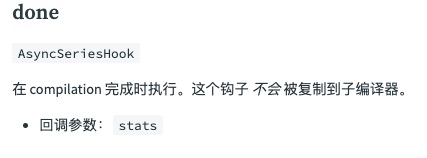webpack-plugin
目的
插件目的在于解决 loader 无法实现的其他事
plugin 原理
Webpack 的插件机制,是一种事件流的机制,按照一定的顺序,依次触发�对应的事件。
webpack 内部使用 tapable 拓展了类,用来注册和调用事件。
// 注册事件
this.hooks.emit.tap(compilation, err => { /* ... */ }); // 注册同步事件
this.hooks.emit.tapAsync(compilation, err => { /* ... */ }); // 注册异步事件
// 调用事件
this.hooks.emit.call(compilation, err => { /* ... */ }); // 调用同步事件
this.hooks.emit.callAsync(compilation, err => { /* ... */ }); // 调用异步事件
Webpack 的执行过程中,在不同的阶段,会调用对应的事件,这保证了插件的有序性。用户只需要根据执行阶段在对应的钩子上注册事件即可。
compiler 和 compilation
- Compiler:该对象包含了 Webpack 环境所有的的配置信息,包含 options、loaders 和 plugins 这些信息,以及webpack执行阶段的生命周期。这个对象在 Webpack 启动时候被实例化,它是全局唯一的,可以简单地把它理解为 Webpack 实例。
- Compilation:该对象包含了当前的模块资源、编译生成资源、变化的文件等。当 Webpack 以开发模式运行时,每当检测到一个文件变化,一次新的 Compilation 将被创建。Compilation 对象也提供了很多事件回调供插件做扩展。通过 Compilation 也能读取到 Compiler 对象。
compiler 钩子
Compiler 模块是 webpack 的主要引擎,它通过 CLI 或者 Node API 传递的所有选项创建出一个 compilation 实例。它扩展(extends)自 Tapable 类,用来注册和调用插件。 大多数面向用户的插件会首先在 Compiler 上注册。
可以通过如下方式访问:
compiler.hooks.someHook.tap('MyPlugin', (params) => {
/* ... */
});
具体的钩子说明可以看: compiler 钩子 | webpack 中文文档
compilation 钩子
Compilation 模块会被 Compiler 用来创建新的 compilation 对象(或新的 build 对象)。 compilation 实例能够访问所有的模块和它们的依赖(大部分是循环依赖)。 它会对应用程序的依赖图中所有模块, 进行字面上的编译(literal compilation)。 在编译阶段,模块会被加载(load)、封存(seal)、优化(optimize)、 分块(chunk)、哈希(hash)和重新创建(restore)。
可以通过如下方式访问:
compilation.hooks.someHook.tap('MyPlugin', (params) => {
/* ... */
});
具体的钩子说明可以看:compilation 钩子 | webpack 中文文档
用法
配置方式
webapck.config.js
const HtmlWebpackPlugin = require('html-webpack-plugin');
const webpack = require('webpack'); // 访问内置的插件
const path = require('path');
module.exports = {
entry: './src/index.js',
output: {
path: path.join(__dirname, './dist')
},
module: {
rules: [
{
test: /\.(js|jsx)$/,
use: 'babel-loader',
},
],
},
plugins: [
new webpack.ProgressPlugin(),
new HtmlWebpackPlugin({ template: './src/index.html' }),
],
};
Node API 方式
const webpack = require('webpack'); // 访问 webpack 运行时(runtime)
const configuration = require('./webpack.config.js');
let compiler = webpack(configuration);
new webpack.ProgressPlugin().apply(compiler);
compiler.run(function (err, stats) {
// ...
});
如何写一个插件
webpack 在注册时,执行插件的 apply 方法plugin.apply(compiler)。所以我们在写插件时,把事件注册写在apply内。
如下:
const pluginName = 'ConsoleLogOnBuildWebpackPlugin';
class ConsoleLogOnBuildWebpackPlugin {
apply(compiler) {
compiler.hooks.run.tap(pluginName, (compilation) => {
console.log('webpack 构建正在启动!');
});
}
}
module.exports = ConsoleLogOnBuildWebpackPlugin;
Compiler hook 的 tap 方法的第一个参数,应该是驼峰式命名的插件名称。建议为此使用一个常量,以便它可以在所有 hook 中重复使用。
一个简单 Analyze 插件
首先我们需要分析一下 Analyze 插件有什么?
- 分析的数据
- 展示数据的页面
确认执行阶段
要有分析的数据,那么就要先确定在哪个阶段进行获取,我们知道在整个 webpack 的执行过程中,compilation 负责每一次的模块的编译。只有等 compilation 结束之后,我们才能够拿到模块编译的结果。根据这个我们就可以去找在哪个生命周期 compilation 结束。
在 compiler 的 done 生命周期钩子,在 compilation 完成时执行。

class AnalyzerPlugin {
apply(compiler) {
compiler.hooks.done.tapAsync('analyzerPlugin', (stats, callback) => {
});
}
}
获取分析数据
Webpack 可分析的数据有非常多的,比如时间、chunk和bundle等。
在 done 回调中返回的 stats 是有包含相�应的信息的,这里我们以模块的部分信息为例进行分析。
function getModules(stats) {
const modules = stats.toJson().modules.map(({ type, size, name, id, depth }) => {
return {
type,
size,
name,
id,
depth
};
});
return modules
}
展示数据
展示数据有两种方式。
第一种就是通过 console.log(),直接在终端进行展示,比较简单,但是不好用。
class AnalyzerPlugin {
apply(compiler) {
compiler.hooks.done.tapAsync('analyzerPlugin', (stats, callback) => {
const modules = getModules(stats)
console.log(modules)
});
}
}
第二种就是在页面中进行展示。
首先我们通过 node 的 http 模块创建一个 server,内容是我们自定义的 html 模版。
function createServer(modules) {
const server = http.createServer((req, res) => {
if (req.method === 'GET' && req.url === '/') {
const html = renderViewer({
title: 'MyAnalyzerPlugin',
data: modules
});
res.writeHead(200, { 'Content-Type': 'text/html' });
res.end(html);
}
});
return server
}
启动这个服务,并通过 opener 在服务启动成功之后的回调里,自动打开浏览器页面进行展示。
function serverListen(server){
const port = 8888;
const host = '127.0.0.1';
server.listen(port, host, () => {
const url = `http://${host}:${port}`;
opener(url);
})
}
完整代码:
const http = require('http');
const opener = require('opener');
class AnalyzerPlugin {
apply(compiler) {
compiler.hooks.done.tapAsync('analyzerPlugin', (stats, callback) => {
const modules = getModules(stats)
const server = createServer(modules)
serverListen(server)
});
}
}
function getModules(stats) {
const modules = stats.toJson().modules.map(({ type, size, name, id, depth }) => {
return {
type,
size,
name,
id,
depth
};
});
return modules
}
function createServer(modules) {
const server = http.createServer((req, res) => {
if (req.method === 'GET' && req.url === '/') {
const html = renderViewer({
title: 'MyAnalyzerPlugin',
data: modules
});
res.writeHead(200, { 'Content-Type': 'text/html' });
res.end(html);
}
});
return server
}
function serverListen(server){
const port = 8888;
const host = '127.0.0.1';
server.listen(port, host, () => {
const url = `http://${host}:${port}`;
opener(url);
})
}
function renderViewer({ title, data } = {}) {
return `<!DOCTYPE html>
<html>
<head>
<meta charset="UTF-8" />
<meta
name="viewport"
content="width=device-width, initial-scale=1"
/>
<title>${title}</title>
</head>
<body>
<div id="app">
<table>
<thead>
<tr>
<th>type</th>
<th>size</th>
<th>name</th>
<th>id</th>
<th>depth</th>
</tr>
</thead>
<tbody>
${data.map((item) => {
return `<tr>
<td>${item.type}</td>
<td>${item.size}</td>
<td>${item.name}</td>
<td>${item.id}</td>
<td>${item.depth}</td>
</tr>`;
})}
</tbody>
</table>
</div>
</body>
</html>`;
}
module.exports = AnalyzerPlugin;
最终的效果如下:

参考文献